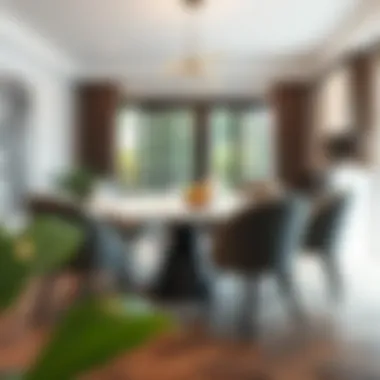Round Kitchen Tables and Fabric Chairs: A Design Guide


Intro
In contemporary interior design, the interplay between round kitchen tables and fabric chairs has gained significant attention. This combination not only shapes the aesthetics of dining areas but also influences various aspects of the eating experience. In homes where functionality meets style, understanding the dynamics of how these pieces interact becomes essential for designers, retailers, and homeowners alike. Today, we will delve into the current trends, maintenance practices, and much more while uncovering how to create inviting kitchen spaces that resonate with modern tastes.
Furniture Trends
Current Design Aesthetics
The trend toward round kitchen tables paired with fabric chairs reflects a shift in how people view their living spaces—more welcoming, relaxed, and communal. The curves of a round table encourage conversation, breaking down barriers that rectangular tables inherently possess. Many homeowners seek to foster connection among family and friends during meals, and a round table can be pivotal in achieving that atmosphere.
Current aesthetics often lean on minimalistic designs, with many opting for clean lines in combination with soft textures. Fabrics like cotton, velvet, and linen are being favored for their tactile quality and variety of colors. Designers are gravitating toward muted earth tones or bold, vibrant hues, depending on the overall style of the kitchen. These decisions can transform ordinary dining experiences into something much more engaging.
Additionally, mixing materials is a rising trend—think of a sturdy wooden table complemented by plush fabric chairs. It's a combination that balances robustness with comfort, creating an inviting dining area.
Innovative Materials and Technologies
When it comes to materials, innovation has shifted the landscape quite a bit. Fabric chairs are now available in a multitude of options, including stain-resistant treatments and eco-friendly materials. These innovations not only cater to aesthetic preferences but also enhance practicality.
Taking a closer look at fabric options, high-performance textiles are gaining traction. Brands are rolling out materials like Sunbrella fabric, which is known for its durability and resistance to fading, making it ideal for kitchens. Moreover, the rise of smart technologies in furniture design means that more manufacturers are experimenting with integrated functionalities in fabric chairs, enhancing comfort and usability without compromising style.
"The combination of practicality and aesthetics in furniture choices is essential for modern living, especially in kitchens where families gather."
Maintenance and Care
Cleaning and Upkeep Tips
Maintaining the appearance of round kitchen tables and fabric chairs can be quite straightforward with a little know-how. Here are some handy tips to keep everything looking fresh:
- Routine Dusting: Regularly dust both the table and chairs to prevent dirt buildup. Use a microfiber cloth to lift dust without scratching surfaces.
- Spot Cleaning: For fabric chairs, immediate spot treatment is key. A mix of mild soap and water often does the trick, but remember to test on a hidden area first.
- Protective Covering: Consider using a tablecloth or placemats to protect the surface of your table from scratches or heat damage.
- Professional Cleaning: For deeper cleaning, sometimes it's best to call in professionals, especially if you’re dealing with delicate fabrics or intricate wood designs.
Repair and Restoration Techniques
Over time, wear and tear can make even the most robust furniture look aged. Here’s what to do when repairs are needed:
- Upholstery Repair: For fabric chairs, if you notice fraying or stains that won't come out, reupholstering might be the way to go. Find a fabric that complements your kitchen's design theme to refresh their look.
- Wood Restoration: For wood tables, simple refinishing can bring back shine and luster. A bit of sandpaper followed by a coat of polish can work wonders.
- DIY Solutions: For minor scratches in the table's surface, a paste of walnut oil and vinegar can be applied lightly to hide imperfections.
By emphasizing thoughtful maintenance and stylish design, homeowners can create not just functional areas, but nurturing environments that truly elevate the dining experience.
The Appeal of Round Kitchen Tables
Round kitchen tables hold a unique charm in contemporary interior design that is hard to overlook. They embody a sense of intimacy and warmth, making gatherings feel effortless and inviting. Unlike their rectangular cousins, round tables promote inclusiveness—everyone seated is equidistant, encouraging conversation and connection. This dynamism is particularly important in open-concept homes where the kitchen often doubles as a social hub.
Furthermore, the circular design contributes to a more organic flow in the kitchen space. Many homeowners find themselves drawn to this type of table due to its versatility. It can fit snugly into a corner or stand proudly in the center of the room, adapting easily to various layout scenarios without imposing too much on the area. It’s like the Swiss Army knife of kitchen furniture, suitable for both formal dinners and casual breakfasts.
Historical Context
Historically, round tables have been used in various cultures as symbols of equality and democracy. Think of King Arthur and his Round Table, which represented unity among equals. Fast forward to the 20th century, where mid-century modern design embraced this shape, championing sleek lines and functional beauty. The appeal remains steadfast, evolving with trends but never losing that essence of shared experiences. Round tables can be seen as timeless pieces that transcend fleeting fashion statements. They anchor both traditional and modern kitchens, making them perpetually appealing.
Design Versatility
One of the most compelling attributes of round kitchen tables is their design versatility. Available in an array of materials, from wood to glass, and an endless selection of finishes and colors, these tables can seamlessly blend into any aesthetic. For example, a reclaimed wood table exudes rustic charm, while a sleek, glossy glass table conveys modern elegance. This flexibility extends not only to style but also to size. Depending on the spatial constraints of your kitchen, you can choose a small bistro-style table for intimate meals or a larger one for family gatherings. This makes round tables highly adaptable, suitable for urban apartments as well as spacious family homes.
Space Optimization
Space is often a concern for homeowners, especially in smaller kitchens. Round tables shine in this area as their design inherently saves space. Without sharp corners extending into foot traffic areas, round tables allow for better movement and flow throughout the kitchen. You could easily tuck a round table into nooks that would be unutilized otherwise. Moreover, the absence of angular edges means that more people can gather around comfortably, making it easier to fit a few extra chairs during festive occasions. Ensuring a perfect balance between functionality and aesthetics, round kitchen tables stand out as an ideal choice for those looking to maximize every inch of their kitchen while maintaining visual harmony.
"In a well-designed kitchen, every piece of furniture plays a role in crafting an experience, and the round table invites conversation like no other."
Fabric Chairs: Aesthetic and Functional Benefits
When considering the interplay of round kitchen tables and fabric chairs, the choice of seating is not just about looks. It’s about how those choices enrich the dining experience and overall aesthetic of the space. Fabric chairs bring personality and comfort to the table, literally and figuratively, influencing both style and functionality in your kitchen. Their diverse materials, ergonomic designs, and ability to mesh with various décor styles are essential to understanding their role.
Variety of Fabrics
The fabric chosen for chairs contributes significantly to the overall atmosphere of the kitchen. Let’s dig deeper into three common types of fabrics used in kitchen chairs.
Cotton
Cotton fabric is a staple in chair upholstery. It’s widely recognized for its softness and durability. One of its primary benefits is breathability, making it cozy to sit on even in the warmest of kitchens. The versatility of cotton allows for a vast range of colors, patterns, and weaves, which can sync well with a variety of décor themes. However, cotton can absorb spills easily, so heed caution with messy eaters or frequent gatherings. It requires regular maintenance to keep it looking fresh.


Linen
Linen brings a natural elegance that is hard to match. Its lightness and unique texture add a touch of sophistication to kitchen chairs. The high absorbency and distinct cooling properties make linen an appealing choice, especially in warmer climates. It has a slight sheen that can elevate the aesthetic of your space. The downside? Linen can wrinkle quite easily, so it may require a bit more care to maintain that crisp appearance.
Synthetic Materials
Synthetic materials, such as polyester and nylon blends, have grown in popularity for good reason. They’re incredibly durable and usually resistant to stains, fading, and wrinkling. This makes them ideal for a bustling kitchen where spills are common. Many synthetic fabrics are designed to mimic the luxurious look of natural fibers while offering enhanced longevity. However, their man-made nature can sometimes lack the soft feel of natural fabrics, which might deter some homeowners from considering them.
Comfort and Ergonomics
Ensuring that fabric chairs are comfortable is paramount. Properly designed chairs should support the back and allow for a relaxed seated position, especially during long family dinners or social gatherings. The right height and depth can significantly influence comfort, preventing strain. Ergonomic considerations are not limited to the seat itself but also include sufficient cushioning and support which enhance the overall dining experience.
Style and Color Coordination
Fabric chairs are available in myriad styles and colors, making the selection process both exciting and overwhelming. Consider the color palette of your kitchen. Neutrals can create a calming ambiance, while vibrant or patterned chairs can become striking focal points. The key here lies in the balance—matching or contrasting effectively with your round table. Whether you’re aiming for a cohesive look or a more eclectic vibe, choose fabrics that emphasize style without overshadowing the core design elements of your kitchen.
"The right fabric chairs not only add comfort but can also transform your dining area into a space that reflects your personal style."
In summary, fabric chairs serve as a blend of aesthetics and function. Understanding the variety of materials available, along with their individual benefits and drawbacks, allows homeowners to make informed choices for their kitchen setup.
Design Trends for Round Tables and Fabric Chairs
The interplay between round kitchen tables and fabric chairs reflects a deeper aesthetic conversation within modern design. When examining design trends, one must consider how these pieces embody the era's spirit while accommodating practical needs. Shifts in lifestyle preferences, spatial arrangements, and fabric innovations set the stage for how homeowners, decorators, and designers make informed choices that elevate dining experiences. Today, we'll explore three key trends that shed light on the evolving landscape of round tables and fabric chairs.
Contemporary Minimalism
In a world increasingly focused on simplicity, contemporary minimalism stands out as a dominant trend. This design philosophy emphasizes the beauty of clean lines, muted color palettes, and functional forms. Round tables, with their soft edges and seamless curves, naturally fit into this aesthetic, promoting a sense of harmony and spaciousness. Fabric chairs in this context often employ linen or cotton blends, materials that are both tactile and understated in design.
Here are essential elements of embracing contemporary minimalism:
- Neutral Tones: Look for tables and chairs featuring shades like soft grays, whites, or beiges.
- Simple Structures: Opt for designs with unembellished silhouettes, steering clear of ornate details.
- Natural Elements: Incorporating wooden or stone finishes can create a warm contrast to fabric and enhance the minimalist ethos.
In this approach, furniture isn’t just about utility; it transforms the kitchen into a serene backdrop for life’s daily moments.
Bohemian Chic
If ever there was a design trend that celebrates artistic expression and a carefree spirit, it is bohemian chic. This trend invites a mix of colors, patterns, and textures, encouraging personal storytelling through decor. A round kitchen table paired with fabric chairs distinguished by rich hues or tribal patterns can serve as a vibrant nexus for creativity and dialogue.
Key aspects of the bohemian chic style include:
- Layering Textiles: Use different fabric types – from velvet to woven fibers – to create a warm, inviting atmosphere.
- Bold Colors: Embrace jewel tones like emerald green or ruby red to make the space pop.
- Eclectic Accents: Accessorize with handmade ceramics and artful tableware, nurturing a sense of uniqueness.
In this trend, the combination of round tables and fabric chairs becomes much more than furniture; it evolves into an expressive palette that reflects the inhabitant’s soul.
Eclectic Compositions
The eclectic approach breaks the mold, merging various design influences to form a visually stimulating environment. Combining different furniture styles can create a uniquely personal touch that feels simultaneously intentional and spontaneous. A centerpiece round table accompanied by fabric chairs of differing designs invites curiosity and conversation.
Characteristics of eclectic compositions include:
- Mix and Match: Combine different chair styles and colors, maintaining cohesion through minor commonalities, such as shared color or material.
- Artful Arrangement: Play with placement and orientation to create dynamic visual interest.
- Personal Artifacts: Include personal mementos or art pieces to infuse character into the space.
While this trend might appear disjointed, it's about telling a story through thoughtfully chosen pieces that resonate on a personal level.
By embodying these design trends, round kitchen tables and fabric chairs become essential elements in home decor. These trends do not only enhance aesthetic appeal but serve as tools for creating meaningful and functional spaces. As preferences evolve, so too does the dialogue around furniture, fostering a deeper connection between the design and its inhabitants.
Combining Functionality with Aesthetics
In modern homes, where every piece of furniture contributes to the overall atmosphere and utility of a space, the combination of functionality and aesthetics is paramount. Round kitchen tables paired with fabric chairs exemplify this balance beautifully. These pieces don’t just serve a purpose—they also elevate the environment, merging practicality with style in a way that invites warmth and connectivity among occupants.
Layout Considerations
Designing a space requires meticulous attention to layout, especially when integrating round tables and fabric chairs. For instance, the circular shape of these tables promotes conversation and removes the barriers that square tables might impose. When arranging a dining area, one must consider the flow of movement, ensuring that there’s enough room for chairs to slide back freely.
- Symmetry or Asymmetry: Depending on your personal style, you might prefer a symmetrical arrangement, where everything lines up neatly, or an asymmetrical layout that feels more relaxed and organic.
- Traffic Flow: Ensure that there’s adequate space around the table. A guideline is to leave about 36 to 48 inches from the edge of the table to the walls or other furniture. It’s about giving everyone a bit of breathing room.
These considerations help create a space that feels neither cramped nor chaotic while allowing for comfortable interactions during meals or gatherings.
The Importance of Scale and Proportion
Every element in the dining area should harmonize through scale and proportion. When choosing a round table and fabric chairs, think about how each will interact with the space. Too large a table in a small kitchen can overwhelm, while a petite table in a spacious room may appear lost.


- Table Height: The standard height for dining tables is around 30 inches, which comfortably accommodates most standard chair heights. However, consider your household’s needs—some families may prefer a higher counter table or a lower coffee table for informal dining.
- Chair Dimensions: Fabric chairs should not just fit neatly under the table but also allow diners to sit comfortably. Look for cushioning and back support that matches your preferences.
Striking this balance ensures that the furniture enhances the room rather than detracts from it. Every piece should complement one another while keeping functionality at the forefront, encouraging enjoyable dining experiences.
Highlighting Focal Points
Every well-designed room has a focal point, and in a dining area featuring a round table and fabric chairs, this can be strategically enhanced to draw attention and create an inviting atmosphere.
- Centerpiece Options: Consider placing an appealing centerpiece on your round table, such as a floral arrangement, candles, or a decorative bowl. This instantly attracts the eye and serves as a conversation starter.
- Color Coordination: Use fabric chairs that either match or contrast elegantly with the table and surrounding decor. For example, if your table features a rustic wood finish, soft pastel colors or bold jewel tones can add dimension and warmth.
"Engineered aesthetics are more than about appearance; they're about setting the stage for connection and shared experiences."
Incoporating these focal points can foster a sense of belonging, making gatherings more enjoyable and encouraging cherished memories. In this way, combining functionality with aesthetics does not solely relate to how furniture looks, but how it feels and operates to promote togetherness.
Maintenance and Care for Fabric Chairs
The upkeep of fabric chairs is often overlooked, yet it's an essential element in maintaining their beauty and functionality. Proper maintenance not only preserves their aesthetic appeal but also enhances the longevity of the pieces. When considering round kitchen tables paired with fabric chairs, understanding how to care for these items becomes pivotal. A well-kept fabric chair contributes to a cohesive and inviting dining atmosphere, which is something every homeowner cherishes.
Cleaning Techniques
Stain Removal
Stain removal is a critical practice for anyone who owns fabric chairs. It serves to protect the visual integrity of the chairs and thereby the entire dining area. One of the key characteristics of effective stain removal is the promptness in treating spills. The sooner one acts, the more likely the stain will come out without leaving a trace.
For instance, a mixture of warm water and mild detergent can do wonders for most everyday stains; however, for tougher spots, a specialized fabric cleaner may be necessary. The unique feature of stain removal techniques is their adaptability to various types of stains—whether it's a drop of grape juice or an errant coffee splash, different treatments can be applied. Adopting a stain removal process, such as these, proves to be a beneficial choice for homeowners aiming to maintain a pristine appearance in their kitchen.
General Maintenance
On another front, general maintenance can’t be ignored. Regular vacuuming is one of the oldest tricks in the book—but it's also one of the most effective. This simple act removes dust and prevents dirt buildup, which can otherwise weaken the fabric over time. A periodic thorough cleaning with products specifically designed for fabric can also keep things fresh.
The unique aspect of general maintenance lies in its simplicity and low-cost nature. Adopting a regular routine not only preserves the fabric’s look but can also prevent more costly repairs or replacements down the line. Thus, practicing general maintenance can save you money and ensure that your fabric chairs look their best year-round.
Protecting Fabric Against Wear
When discussing fabric chairs, protecting them against wear is a vital consideration. The environment in which these chairs are placed can notably impact their lifespan. Utilizing protective sprays or treatments can create a barrier against spills and stains, making regular cleaning much easier. In addition, arranging the seating in a way that minimizes friction—such as not dragging chairs across the floor—can extend their life significantly. Moreover, employing custom slipcovers could provide a layer of protection that is both functional and aesthetic.
Longevity and Durability
Finally, talking about longevity and durability is crucial. The choice of fabric plays a monumental role in how long the chairs will last. For instance, fabrics like microfibre or canvas are known for their durability compared to lighter materials such as cotton. While they may come at a higher initial cost, the investment pays off in the long run because they can withstand the rigors of daily use much better.
Moreover, regular inspection of seams and cushions is often overlooked but can make a huge difference. Addressing issues like loose threads or fraying early can prevent extensive damage and ensure your fabric chairs remain a stylish and functional part of your kitchen for years to come.
"The longevity of fabric chairs not only depends on the quality of materials but also on conscientious maintenance and care practiced regularly."
By understanding and applying these cleaning techniques, maintenance practices, and protective measures, homeowners can greatly enhance the life and appearance of their fabric chairs. It's not just about the looks—it's about creating an inviting space that reflects care and attention.
Psychological Impact of Furniture Arrangement
The arrangement of furniture within our living spaces extends beyond mere aesthetics; it profoundly influences our day-to-day experiences and interactions. Particularly in the context of round kitchen tables paired with fabric chairs, understanding the psychological nuances of such an arrangement is crucial. It shapes not only the functionality of the space but also the emotional ambience it provides.
The circular nature of round tables fosters inclusivity, drawing people into a shared space where conversations flow freely. This type of arrangement can enhance feelings of comfort and community, key elements for social dining. Choosing the right furniture combination—such as soft fabric chairs that invite relaxation—can promote a warm atmosphere, making it an ideal setting for both casual family dinners and lively gatherings.
Creating Social Spaces
The kitchen often serves as the heart of the home, the nucleus around which family life revolves. Round tables with fabric chairs encourage engagement and facilitate interactions among guests, transcending the limitations posed by rectangular seating layouts. Unlike a square table, a round one eliminates corners, which can feel segregating. With everyone sitting equidistantly, it prompts discussions that are more natural and vibrant.
When you nestle fabric chairs around a round kitchen table, you produce a welcoming vibe that signals openness. Fabrics add comfort, both visually and physically. If you choose vibrant colors or patterns, it can evoke joy and energy within the space, making it a perfect environment for connections to grow deeper.
Encouraging Interaction
The arrangement of furniture in social settings can make or break the experience. Round tables naturally encourage conversation; they eliminate barriers and enhance visibility. In such setups, conversations can flow uninterrupted across the table, allowing for an easy exchange of ideas and laughter. People do not have to strain to hear one another; instead, they can participate fully in the discourse with only a gentle turn of the head.
The fabric chairs contribute to this interactive experience as well. When chairs are comfortable, guests are more likely to linger, prolonging their stay—essentially turning mealtime into a cherished social event rather than just a routine task. Color choices in fabric can also affect mood, with warm tones creating a sense of coziness, essential for inviting dialogue.
Influencing Mood and Atmosphere
The interplay of furniture arrangement and mood is notably significant. In the realm of interior design, minor details can shift the emotional tone of a space. With the right setup, your kitchen can transform based on the arrangement of tables and chairs.
Round tables bring a sense of equality and unity, whereas the softness of fabric chairs can evoke comfort. Together, they help create a relaxed environment. For example, soft tones like sage green or powder blue in fabric can instill a sense of calmness, while brighter colors can amplify energy, affecting how people feel in that space.
Sustainability Considerations


In the contemporary design landscape, where functionality and aesthetics often steal the spotlight, the topic of sustainability has been gaining traction as a vital consideration. The integration of round kitchen tables and fabric chairs is not only about visual appeal or comfort but also profoundly impacts environmental footprints. Designers and homeowners alike are increasingly aware that choices in these essential furniture pieces can reflect their commitment to sustainability. This section unpacks the major elements related to sustainability in the context of kitchen furniture, underscoring the importance of eco-friendly materials, ethical sourcing, and innovative recycling or upcycling initiatives.
Adopting sustainable practices not only supports the planet but can also provide a unique selling proposition for retailers and designers. When consumers choose furniture made from eco-conscious sources, they create spaces that are not just liveable but also responsible.
Eco-friendly Materials
When evaluating fabrics for chairs and the materials for round kitchen tables, it's crucial to prioritize eco-friendly options. Materials like bamboo, reclaimed wood, and organic cotton come into play here. Bamboo, for instance, grows rapidly and requires fewer resources compared to traditional hardwoods; it's not only sustainable but can also impart a unique character to the surroundings.
Beyond wood, many fabrics use dyes and treatments that can contain harmful chemicals; however, options like organic linen or untreated cotton shine in this regard. Using these natural textiles minimizes the release of harmful VOCs (volatile organic compounds) into the air, making homes healthier too. Moreover, utilizing recyclable materials in table construction reduces waste and limits the demand for new resources. Another trend worth mentioning includes the use of post-consumer plastics for upholstery, which pulls waste out of landfills and reintroduces it into the market.
Ethical Sourcing and Production
The journey from material to finished product holds tremendous power over sustainability. Ethical sourcing involves ensuring that the materials are obtained in a manner that respects both the environment and the communities involved in production. This means supporting manufacturers who practice fair trade and operate under labor laws that provide safe working conditions. A round kitchen table crafted from responsibly sourced wood, for instance, speaks volumes about its maker's integrity—one that values not just profit, but also people and the planet.
Transparency in production is another vital aspect. Companies showcasing their supply chain details allow consumers to make informed decisions, ensuring that they are investing in furniture that aligns with their values. In addition, employing local artisans can significantly lower transportation emissions, promoting a more sustainable model of production.
Recycling and Upcycling Initiatives
The concept of recycling has evolved into more creative avenues like upcycling, where old furniture gets a fresh twist instead of being discarded. This practice not only saves resources but also offers a unique charm to home decor, as each piece carries a story. For instance, an old round table can be transformed with a coat of non-toxic paint or new fabric on chairs, giving it a second chance at life.
Some manufacturers even provide programs for customers to trade in old pieces for discounts on new furniture, ensuring that their products don’t just end up collecting dust in a landfill. This circular model is advantageous for both consumers and the environment, fostering a sense of responsibility and creativity in home design.
Thus, sustainability considerations in the realm of round kitchen tables and fabric chairs intersect to create meaningful, stylish, and environmentally friendly choices for homeowners and designers alike. In crafting a dining space that is both aesthetically pleasing and socially responsible, the focus on sustainable materials, ethical production practices, and innovative recycling methods can transform a typical kitchen into a space that echoes responsibility and care toward our planet.
"Every piece of furniture tells a story; let yours be one of sustainability and care."
For further reading on sustainability in design, check out resources from organizations like the Environmental Protection Agency and Sustainable Furnishings Council.
Cultural Influences in Furniture Design
Understanding furniture design can’t be fully realized without recognizing the cultural influences that shape it. Different regions bring their unique flair and concepts to pieces we often take for granted in our homes. Within the context of round kitchen tables and fabric chairs, these cultural cues manifest in not just aesthetic choices but also functionality and symbolism.
Regional Styles and Preferences
Every location has its own distinct style when it comes to furniture. For instance, in Scandinavian countries, you'll find a penchant for minimal design, where simplicity takes the front seat. Clean lines and practicality reign supreme, as seen in famed brands like IKEA. On the other hand, Mediterranean designs are often vibrant, infused with colors and intricate patterns, reflecting their rich history and connection to nature. A round table there might feature carved wood with splashes of cheerful hues.
In places like Japan, simplicity extends even deeper into the philosophy of Wabi-sabi, which embraces imperfection. This could translate to a round kitchen table made from untreated wood, showcasing the natural grain. Meanwhile, in regions where communal dining is a tradition, such as in many Latin American cultures, a round table holds significance as a space for gathering, promoting a sense of togetherness.
The integration of these diverse styles into modern homes encourages a blend of old and new, providing a wealth of options for homeowners and designers alike.
Historical Significance of Round Tables
Round tables have long since played a critical role in various cultures. Historically, they are often associated with equality; no one sits at the head, promoting open dialogue and camaraderie. The Round Table of King Arthur stands as a prime example, invoking ideals of unity and fellowship.
In many traditional societies, round tables have been central to feasts and gatherings, symbolizing warmth and inclusivity. Family meals were often held around such tables, and the act of sharing food transcended mere sustenance— it fostered community. This historical context enriches the reasoning behind placing a round kitchen table in modern homes. It’s not simply about aesthetics; it’s about cultivating an atmosphere where relationships flourish.
Symbolism of Round Shapes in Design
Shapes speak volumes in design. Round shapes, specifically, carry strong symbolism — they can represent unity, continuity, and infinity. In the realm of furniture, a round kitchen table embodies a place where family members and friends can come together, breaking bread and sharing life’s moments. The circular nature invites participation from everyone, ensuring that no one feels left out.
Moreover, in Feng Shui, round shapes are believed to promote harmony and balance within a space. This philosophy can influence how people approach their kitchen design, decisions about furniture arrangement, and even the materials chosen for fabric chairs. A round table can act as a focal point in a room, encouraging positive vibes and smooth energies to flow.
Ultimately, the importance of understanding cultural influences in furniture design cannot be overstated. They inform not just the look and feel of our interior spaces but also how we interact within them. As designers, retailers, and homeowners, being aware of these nuances can help craft not only a visually pleasing environment but also one that resonates deeply with personal and communal values.
Future Trends in Kitchen Furniture
The realm of kitchen furniture is ever-evolving, reflecting broader design trends, technological advancements, and changing lifestyles. As modern kitchens morph into multifunctional spaces, the integration of round kitchen tables with fabric chairs becomes even more relevant. Understanding the future trends in kitchen furniture is crucial for anyone looking to create a space that is not just functional but also embraces contemporary aesthetics and comfort. This section delves into significant elements that will shape the future of kitchen furnishings, offering insights into how these developments can benefit homeowners and designers alike.
Technological Innovations
In today’s fast-paced world, technology is becoming an integral part of our furnishings. The rise of smart furniture is a notable trend. Round kitchen tables are no longer just places to dine; they are evolving into multifunctional hubs equipped with smart features.
- Integrated Charging Stations: Many new designs now include in-built USB ports or wireless charging surfaces. This makes it convenient for families to stay connected while enjoying meals together.
- Adjustable Features: Tables that can alter their height or shape based on need are gaining traction. This adaptability provides comfort for people of all ages, whether they’re enjoying a casual dinner or hosting a gathering.
- Smart Surfaces: Advances in technology have also led to the creation of surfaces that resist stains and scratches while providing an aesthetic appeal. For instance, certain materials can change color or texture based on temperature or light, bringing a dynamic element to round tables.
"Incorporating technology into kitchen furniture not only enhances usability but also reflects a contemporary lifestyle that values connectivity and adaptability."
Adapting to Home Automation
With the growing inclination towards home automation, kitchen furniture is beginning to reflect this shift. Homeowners are looking for ways to integrate their furniture with home management systems. Round kitchen tables paired with fabric chairs can serve as centralized points for activating different functions throughout the home.
- Voice-Controlled Features: Imagine adjusting the lighting or playing music from your table using voice commands. This level of convenience encourages more interactive and relaxed dining experiences.
- Customizable Settings: Many homeowners will appreciate the option to customize their dining atmosphere digitally, controlling aspects like temperature or ambiance directly from their table’s interface.
- Energy-Efficient Designs: As sustainability becomes more important, many furniture makers are designing pieces that utilize energy-saving technology. This aligns furniture with the greater energy efficiency goals found in other areas of home automation.
Emerging Design Philosophies
Finally, as trends shift, new design philosophies continue to emerge, influencing how round kitchen tables and fabric chairs are conceptualized. The focus is not just on aesthetics but on a seamless blend of function and beauty.
- Biophilic Design: This approach incorporates natural elements into the kitchen. Expect to find more round tables crafted from sustainable woods or featuring plant-integrated designs that enhance indoor air quality.
- Inclusive Design: There’s a growing emphasis on inclusivity in furniture design. Round tables with comfortable fabric chairs allow for easier maneuverability, making it accessible to everyone, from small children to elderly family members.
- Minimalism: The simplicity of form and function will continue to resonate. Tables will showcase sleek designs that do not overwhelm the space, complementing modern kitchen decor rather than distracting from it.
In summary, the future of kitchen furniture is bright and promising. From technological advancements to emerging design philosophies, the trends point towards a workspace that fully embraces modern living. By understanding these dynamics, consumers and designers can make informed choices that enhance both utility and style in the heart of the home.







